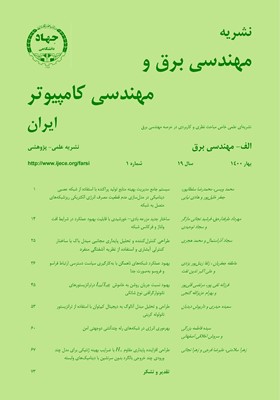بهبود نسبت جریان روشن به خاموش Ion/Ioff درترانزیستورهای نانونوارگرافنی نوع شاتکی
محورهای موضوعی : مهندسی برق و کامپیوترفرزانه تقی پور 1 , مرتضی قلی پور 2 , بهرام عزیزالله گنجی 3
1 - دانشگاه صنعتی نوشیروانی بابل
2 - دانشگاه صنعتی نوشیروانی بابل
3 - دانشگاه صنعتی نوشیروانی بابل
چکیده مقاله :
ترانزیستورهای نانونوار گرافنی نوع شاتکی (SBGNRFET)، علیرغم ویژگیهای بارزی که نسبت به ترانزیستورهای متداول دارند، دارای جریان خاموش نسبتاً زیاد و نسبت پایین میباشند. در این مقاله ساختار جدیدی از ترانزیستور نانونوار گرافنی نوع شاتکی ارائه شده که در آن گیت ترانزیستور به دو قسمت تقسیم شده است. به گیتی که در سمت درین قرار گرفته است، ولتاژ ثابت متصل شده و گیتی که در سمت سورس قرار گرفته است، گیت اصلی ترانزیستور میباشد. ساختار SBGNRFET ارائهشده با مشخصههای هندسی و فیزیکی و در بایاسهای متفاوت با استفاده از شبیهساز عددی مبتنی بر توابع گرین غیر تعادلی شبیهسازی شده و کارایی افزاره مورد ارزیابی قرار گرفته است. نتایج شبیهسازی نشاندهنده بهبود نسبت Ion/Ioff تا 7/6 برابر در V 8/0= VDS میباشد. در این ولتاژ نسبت Ion/Ioff از 2/1 در ترانزیستور SBGNRFET معمولی به 01/8 در ترانزیستور جدید رسیده و جریان خاموش Ioff از µA 5 به µA 7/0 کاهش یافته است. همچنین در V 6/0= VDS، به عنوان ولتاژ تغذیه، نسبت Ion/Ioff از 97/3 به 8/15 و جریان خاموش Ioff از µA 63/0 به µA 16/0 رسیده است.
Schottky-barrier-type graphene nanoribbon transistors (SB-GNRFET), despite their prominent characteristics compared to conventional transistors, have a relatively high off-current and a low Ion/Ioff ratio. In this paper, a new structure of SB-GNRFET is presented in which the gate of the transistor is divided into two parts. A constant voltage is connected to the gate located on the drain side, and the gate located on the source side is the main gate of the transistor. The proposed SB-GNRFET is simulated using non-equilibrium Green functions-based numerical simulator under different geometric and physical characteristics and in biases. The simulation results show Ion/Ioff ratio improvement of up to 6.7-fold at VDS = 0.8 V. At this voltage the ratio has increased from 1.2 in the normal SB-GNRFET transistor to 8.01 in the new transistor and the off current has been reduced from 5 µA to 0.7 µA. Also at VDS = 0.6 V, as the supply voltage, the Ion/Ioff ratio increased from 3.97 to 15.8 and the off current decreased from 0.63 µA to 0.16 µA.
[1] Y. Wu, D. B. Farmer, F. Xia, and P. Avouris, "Graphene electronics: materials, devices, and circuits," in Proc. of the IEEE, vol. 101, no. 7, pp. 1620-1637, Jul. 2013.
[2] Z. Chen, Y. M. Lin, M. J. Rooks, and P. Avouris, "Graphene nano-ribbon electronics," Physica E: Low-Dimensional Systems and Nanostructures, vol. 40, no. 2, pp. 228-232, Dec. 2007.
[3] M. Zoghi, A. Yazdanpanah Goharrizi, and M. Saremi, "Band gap tuning of armchair graphene nanoribbons by using antidotes," J. of Electronic Materials, vol. 46, no. 1, pp. 340-346, Jan. 2017.
[4] A. C. Neto, F. Guinea, N. M. Peres, K. S. Novoselov, and A. K. Geim, "The electronic properties of graphene," Review of Modern Physics, vol. 81, no. 1, pp. 109-162, Jan. 2009.
[5] A. A. Balandin, et al., "Superior thermal conductivity of single-layer graphene," Nano Lett., vol. 8, no. 3, pp. 902-907, Feb. 2008.
[6] A. Yazdanpanah Goharrizi, M. Zoghi, and M. Saremi, "Armchair graphene nanoribbon resonant tunneling diodes using antidote and BN doping," IEEE Trans. on Electron Devices, vol. 63, no. 9, pp. 3761-3768, Sept. 2016.
[7] M. Saremi, M. Saremi, H. Niazi, and A. Yazdanpanah Goharrizi, "Modeling of lightly doped drain and source graphene nanoribbon field effect transistors," Superlattices and Microstructures, vol. 60, no. 1, pp. 67-72, Aug. 2013.
[8] Y. Y. Chen, et al., "A SPICE-compatible model of graphene nano-ribbon field-effect transistors enabling circuit-level delay and power analysis under process variation," in Proc. IEEE Design, Automation & Test in Europe Conf. & Exhibition, DATE’13, pp. 1789-1794, Grenoble, France, 18-22 Mar. 2013.
[9] M. Gholipour, Y. Y. Chen, A. Sangai, and D. Chen, "Highly accurate SPICE-compatible modeling for single-and double-gate GNRFETs with studies on technology scaling," in Proc. of the Conf. on Design, Automation & Test in Europe, 6 pp., Dresden, Germany, 24-28 Mar. 2014.
[10] Y. Y. Chen, A. Sangai, M. Gholipour, and D. Chen, "Schottky-barrier-type graphene nano-ribbon field-effect transistors: a study on compact modeling, process variation, and circuit performance," in Proc. of the IEEE/ACM Int. Symp. on Nanoscale Architectures, pp. 82-88, Brooklyn, NY, USA, 15-17 Jul. 2013.
[11] M. Gholipour, Y. Y. Chen, A. Sangai, N. Masoumi, and D. Chen, "Analytical SPICE-compatible model of Schottky-barrier-type GNRFETs with performance analysis," IEEE Trans. on VLSI Systems, vol. 24, no. 2, pp. 650-663, Feb. 2016.
[12] M. Gholipour, N. Masoumi, Y. Y. C. Chen, D. Chen, and M. Pourfath, "Asymmetric gate Schottky-barrier graphene nanoribbon FETs for low-power design," IEEE Trans. on Electron Devices, vol. 61, no. 12, pp. 4000-4006, Dec. 2014.
[13] M. B. Nasrollahnejad and P. Keshavarzi, "Inverse stone throwers wales defect and enhancing ION/IOFF ratio and subthreshold swing of GNR transistors," The European Physical J. Applied Physics, vol. 86, no. 2, Article No.: 20202, 14 pp., May 2019..
[14] P. Michetti and G. Iannaccone, "Analytical model of one-dimensional carbon-based schottky-barrier transistors," IEEE Trans. on Electron Devices, vol. 57, no. 7, pp. 1616-1625, Jul. 2010.
[15] B. Streetman and S. Banerjee, Solid State Electronic Devices, 6th Ed., Upper Saddle River, N.J.: Pearson/Prentice Hall, 2006.
[16] N. H. Frank and L. A. Young, "Transmission of electrons through potential barriers," Phys. Rev., pp. 80-86, Jul. 1931.
[17] H. S. P. Wong and D. Akinwande, Carbon Nanotube and Graphene Device Physics, Cambridge University Press, 2011.
[18] Y. Taur and T. H. Ning, Fundamentals of Modern VLSI Devices, Cambridge University Press, 2013.
[19] -, NanoTCAD ViDES, Accessed on Mar. 2019. [Online]. Available: http://vides.nanotcad.com/vides.
[20] S. Datta, Quantum Transport, Atom to Transistor, Cambridge University Press, USA, 2005.


